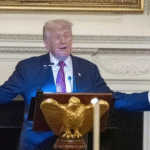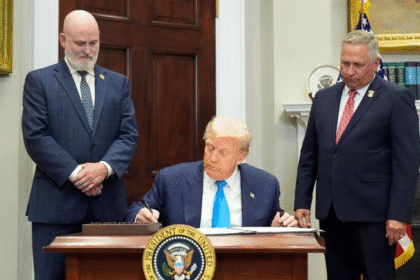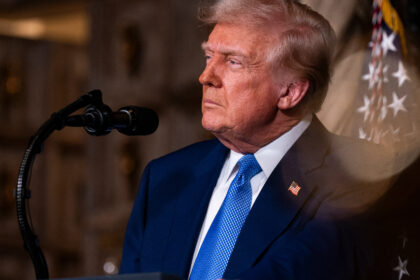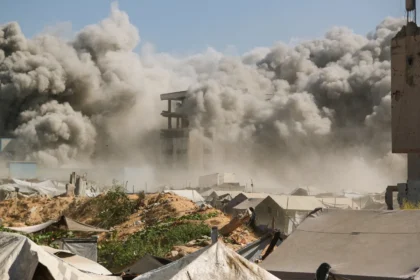Donald Trump’s Foreign Policy Legacy — From Fighter Jets to Near Wars
A Return to the Spotlight
Former U.S. President Donald J. Trump, never one to shy away from bold declarations, recently reignited global headlines with another provocative remark. Speaking to supporters and media, Trump asserted that during his administration, “jets were shot down”, and that he had prevented numerous wars, including one between India and Pakistan—a conflict he claimed could have escalated into a full-scale war if not for his intervention.
The statement, characteristically dramatic and broad, fits into a larger pattern of Trump’s political style: bold storytelling anchored in selective fact, delivered with confidence, and wrapped in geopolitical weight. While such remarks are often brushed aside by his critics as self-congratulatory or even exaggerated, they warrant deeper analysis—because they reflect not only Trump’s foreign policy posture but also how he seeks to frame his presidential legacy in a volatile 21st-century world order.
Jets, Diplomacy, and Theatrics
In Trump’s account, “jets were shot down” on his watch, a likely reference to the 2019 India-Pakistan military standoff that followed the Pulwama terror attack. The conflict escalated to the point where both countries conducted airstrikes across the Line of Control (LoC), and at least one Indian fighter jet—a MiG-21 Bison—was shot down by Pakistan. Wing Commander Abhinandan Varthaman was captured and later released in what many believed was a gesture of de-escalation.
Trump’s retelling subtly positions himself as the decisive actor who diffused the crisis behind the scenes. “I stopped a lot of wars,” he said, crediting himself for stepping in before things spiraled. This remark, while lacking public documentation of direct intervention, aligns with reports that the U.S. State Department and the Trump White House were in urgent backchannel contact with both New Delhi and Islamabad during that critical period.
Yet, the statement also serves a dual purpose. It elevates Trump’s status as a global power broker, and it implicitly critiques the Biden administration’s foreign policy approach by contrasting it with his own “strongman” diplomacy—deal-making through pressure, personal rapport, and threats rather than multilateral process.
The 2019 India-Pakistan Standoff: A Closer Look
To understand the context behind Trump’s claim, we must revisit February 2019. A suicide bombing in Pulwama, Kashmir killed 40 Indian CRPF personnel, an attack claimed by the Pakistan-based terror group Jaish-e-Mohammed. The Indian government responded with an airstrike deep inside Pakistan’s Balakot region, targeting what it claimed was a terror training camp.
Pakistan retaliated with its own airstrike across the LoC, and in the skirmish that followed, Wing Commander Abhinandan’s jet was downed, and he was taken prisoner. For 48 hours, the world watched as two nuclear-armed neighbors edged dangerously close to war. Behind the scenes, global diplomatic channels activated instantly—including those in Washington, D.C.
While there is no public record directly attributing Pakistan’s decision to release the Indian pilot to Trump’s involvement, it is widely acknowledged that the United States, Saudi Arabia, and UAE all played crucial roles in urging restraint. In this light, Trump’s assertion may not be as exaggerated as it seems—though the nuance is often lost in his trademark delivery.
Trump’s Style: Foreign Policy as Theater
What distinguishes Trump’s approach to foreign policy is not merely what he claims to have done, but how he presents it. Throughout his presidency, Trump framed his leadership as a counterpoint to what he often called “globalist weakness”—a preference for direct engagement over bureaucratic diplomacy, for personal calls over multi-nation conferences.
In his narrative, complex geopolitical flashpoints are boiled down to singular moments of strength: threats to North Korea’s Kim Jong-un with “fire and fury”; the Soleimani drone strike as a “message”; and now, the claim of preventing a nuclear war between India and Pakistan. Whether factually airtight or not, these stories reinforce Trump’s self-image as a man who makes hard decisions and gets immediate results.
Critics, however, argue that this narrative masks deeper inconsistencies: unpredictability, sidelining of experts, erosion of traditional alliances, and foreign policy by instinct rather than intelligence. Still, Trump’s narrative resonates with a large segment of the American public that sees strength and disruption as necessary correctives to decades of what they perceive as passive diplomacy.
India-Pakistan Relations: Still a Fragile Balancing Act
Though peace held in 2019 and Wing Commander Abhinandan returned to India safely, tensions between India and Pakistan remain perennially volatile. The core disputes—over Kashmir, cross-border terrorism, and regional influence—remain unresolved. Trump’s claim of preventing a war between the two countries therefore oversimplifies a larger, ongoing dynamic in South Asia.
However, it does highlight a critical truth: American influence continues to serve as a moderating factor in South Asia, particularly in moments of crisis. Whether through diplomatic pressure, intelligence sharing, or military restraint advisories, Washington plays a quiet but strategic role in the subcontinent’s stability—regardless of who is in office.
A Legacy Trump Wants to Define
As Trump gears up for another presidential run, remarks like these are not just rhetorical—they are strategic. By invoking the image of wars averted and peace maintained through strength, Trump is building a foreign policy legacy narrative—one where he is not only the “America First” president but also the global dealmaker who kept world wars at bay.
Whether history will validate this legacy remains to be seen. But what’s certain is that Trump’s version of history—compelling, dramatized, and absolute—will shape voter perception. The India-Pakistan conflict of 2019 may be receding in international memory, but for Trump, it is a trophy of leadership, invoked again and again to remind the world what he believes was lost after 2020.
The Making of a Narrative
Former President Donald Trump’s recurring statement — “I stopped a lot of wars” — is more than just campaign bravado. It’s the foundational pillar of the foreign policy legacy he wishes to construct. By citing conflicts that never escalated, such as the India-Pakistan standoff of 2019, or his contentious but unprecedented talks with North Korean leader Kim Jong-un, Trump is deliberately shaping a political narrative: that the world was safer under his command.
But does this narrative stand up to scrutiny? Was his approach truly a moderating influence on the world stage, or was it simply a fortunate convergence of timing, deterrence, and external diplomacy that prevented escalation? This part examines Trump’s broader foreign policy maneuvers and how they shaped — or avoided — military confrontations during his four-year term.
Beyond South Asia: Other “Wars” Trump Claims He Prevented
In addition to the India-Pakistan conflict, Trump has also taken credit for avoiding wars with North Korea, Iran, Russia, and even Venezuela. He rarely references these episodes in technical or procedural detail, choosing instead to present them as moments of brinkmanship defused by personal strength or bold leadership.
- North Korea: Trump’s “love letters” with Kim Jong-un and the historic DMZ handshake were viewed both as groundbreaking and naive. While tensions cooled during his term, North Korea continued to develop its missile program in defiance of UN resolutions. The détente was fragile and theatrical, but no missiles flew toward Guam or Seoul. Was peace kept? Arguably yes — but not permanently.
- Iran: After withdrawing from the Joint Comprehensive Plan of Action (JCPOA) in 2018, Trump maintained a policy of “maximum pressure,” culminating in the drone strike that killed General Qassem Soleimani in January 2020. While this led to intense retaliation from Tehran, the conflict did not escalate into full-scale war. Trump claims this as a strategic victory in deterrence; critics see it as reckless brinksmanship.
- Russia and Venezuela: Trump has often claimed that his “strength” kept Vladimir Putin at bay — a claim challenged by critics who cite his reluctance to confront Moscow on election interference or Ukraine. In the case of Venezuela, his administration imposed sanctions and supported opposition leader Juan Guaidó, but avoided direct military intervention, unlike previous American stances in Latin America.
In each of these cases, Trump’s messaging follows a consistent template: a near-crisis, a decisive moment, and a peaceful outcome. The factual and diplomatic record, however, is more complex.
The Diplomacy Behind the Curtain
While Trump credits himself personally for avoiding war in the India-Pakistan case, diplomatic records and regional sources paint a broader picture of collective pressure from key allies. In 2019, during the Balakot crisis, the U.S. State Department, National Security Council, and diplomatic envoys in Islamabad and New Delhi were fully engaged.
According to reports published later, it was then U.S. Secretary of State Mike Pompeo, not Trump himself, who conducted late-night calls with Indian and Pakistani officials urging de-escalation. The Pentagon maintained readiness but avoided provocative actions. Allies like Saudi Arabia and the UAE also played key roles in soft diplomacy, with Pakistan’s military taking their cues from trusted regional partners.
It is also worth noting that Prime Minister Narendra Modi and Pakistan’s Prime Minister Imran Khan had their own political calculations to make. Pakistan’s quick return of the captured Indian pilot was as much a PR move as a diplomatic one. In short, a complex web of diplomatic urgency, public pressure, and strategic caution helped prevent the war—not a single leader’s decision.
Trump’s self-insertion into this narrative serves more to consolidate his image as a global peacemaker than to reflect operational reality. However, that doesn’t mean he had no role at all. Presidential directives and tone-setting do matter, especially in moments of crisis. But the execution often lies with career diplomats, intelligence officers, and regional stakeholders who operate beyond the spotlight.
Transactional vs. Traditional Diplomacy
Trump’s foreign policy style—often labeled as transactional diplomacy—stood in contrast to traditional American multilateralism. He viewed alliances as business deals, military threats as leverage, and direct personal engagement as a shortcut to institutional deadlock.
This approach, while criticized as superficial, had some short-term wins. NATO countries were pressured into increasing defense spending. China was brought into a prolonged trade negotiation process. Middle Eastern nations signed onto the Abraham Accords, normalizing relations with Israel.
Yet this same approach failed to create enduring stability in several regions:
- The Taliban regained strength in Afghanistan, culminating in the U.S. withdrawal under Biden.
- North Korea never truly halted its missile testing programs.
- Iran hardened its regional posture following the JCPOA exit.
These shortcomings highlight the limitations of transactional diplomacy. Without a broader framework of trust, policy continuity, and strategic investment, Trump’s approach achieved short-lived gains but limited institutional legacy.
The Politics of “Wars Prevented”
There’s another dimension to Trump’s claim: its political utility. In the current U.S. political climate, where international conflicts (like Ukraine and Gaza) dominate headlines, Trump’s messaging cuts through with one key line: “None of this happened on my watch.”
By highlighting peace, or at least the absence of new wars, he distinguishes his presidency from both Obama’s interventionist impulses and Biden’s current entanglements. It’s a powerful message for war-weary voters, especially in a post-Iraq, post-Afghanistan America still coping with the human and financial cost of 20 years of war.
But historical comparisons require balance. President Dwight Eisenhower also claimed peace through strength. Ronald Reagan used deterrence and dialogue in equal measure. The difference is that Trump centers himself, rather than the institutions of American power, as the source of peace. For his base, this works. For historians, it raises more questions than it answers.
How Indian Diplomacy Perceived the 2019 Standoff
In the wake of the February 2019 Pulwama terror attack, in which over 40 Indian CRPF personnel were killed, tensions between India and Pakistan surged dangerously. India responded with airstrikes in Balakot, targeting what it claimed was a terror training camp operated by Jaish-e-Mohammed. Pakistan retaliated with its own air force operations, and both nations briefly appeared poised for escalation. A captured Indian pilot further intensified the standoff.
In the U.S., then-President Donald Trump, attending a summit in Vietnam with North Korea’s Kim Jong-un, made brief but cryptic remarks that “something big” was happening in South Asia and that the U.S. was engaged in discussions. Days later, Pakistan returned the captured pilot, Wing Commander Abhinandan Varthaman, and de-escalation followed.
According to Indian diplomatic sources, while the United States played an important backchannel role, the decisive factors were India’s calibrated military posture and Pakistan’s internal and international pressures, particularly from China, Saudi Arabia, and the UAE. Indian officials have been cautious in acknowledging any direct Trump influence. New Delhi prefers to portray its handling of the situation as autonomous, measured, and sovereign.
Privately, however, Indian intelligence and defense sources have acknowledged that Washington’s pressure on Islamabad—notably through diplomatic messaging and defense attaché coordination—was significant in preventing further conflict.
Still, Trump’s claim of personally preventing a war does not align with the detailed records of how the situation was managed diplomatically. The heavy lifting, Indian analysts argue, was done by bureaucratic channels, not a late-stage presidential directive.
Pakistan’s Perspective on U.S. Mediation
From the Pakistani side, the narrative is more ambivalent. While Pakistani leaders have, at various times, lauded Trump’s offer to mediate the Kashmir conflict — a statement that drew sharp rebuke from India — they have also attempted to position their military response in 2019 as a demonstration of “restraint with strength.”
The Pakistani government under Imran Khan used Trump’s interest in regional stability to push for American recognition of its strategic concerns in Kashmir and Afghanistan. But after the Balakot incident, Islamabad’s move to return the Indian pilot was widely seen as an attempt to gain moral high ground, not as a concession to U.S. demands.
That said, U.S. pressure was undeniably part of the calculus. The IMF negotiations that Pakistan was undergoing at the time, combined with the fear of international isolation, made the costs of escalation clear. In this context, Trump’s administration—particularly Secretary of State Mike Pompeo—acted as a de-escalatory force, even if the president himself was largely symbolic in that process.
Thus, while Pakistan appreciated the diplomatic intervention, its leadership did not endorse Trump’s narrative of unilateral peacekeeping.
South Asian Public Opinion: Perceptions and Realities
Among the Indian public, Trump’s remark resurfaced memories of American attempts to internationalize the Kashmir dispute, a longstanding red line for Indian policymakers. The suggestion that the U.S. “stopped a war” implies that India lacked control over its own security decisions—a notion rejected across the political spectrum in New Delhi.
Meanwhile, in Pakistan, where Trump was seen more favorably during certain phases of his presidency, reactions were mixed. While some viewed his interest in South Asia as refreshing, others saw his remarks as grandstanding with limited substance.
In both countries, foreign policy experts largely agree on one point: Trump’s rhetoric overstates his role. The 2019 standoff was one of many moments in the subcontinent where nuclear-armed adversaries danced close to the edge—and de-escalation happened through a combination of internal deliberation, regional pressure, and international mediation. Trump was part of that ecosystem, not the engine.
Historical Precedents: The U.S. in India-Pakistan Crises
To assess Trump’s claims in context, it’s important to recall previous instances of U.S. mediation during India-Pakistan crises:
- 1971 War: During the Bangladesh Liberation War, the Nixon administration backed Pakistan and sent the USS Enterprise into the Bay of Bengal. India, under Indira Gandhi, pushed forward with decisive military action. U.S. pressure had little effect.
- 1999 Kargil War: President Bill Clinton played a pivotal behind-the-scenes role, convincing Pakistan’s Prime Minister Nawaz Sharif to pull back troops. Clinton’s mediation was more direct and documented than Trump’s.
- 2001 Parliament Attack: After the Indian Parliament was attacked, both countries mobilized troops to the border. The U.S., under George W. Bush, worked closely with both sides to defuse tensions.
Trump’s 2019 involvement lacks the transparency, depth, and strategic engagement of these earlier efforts. Yet he claims credit in a way that simplifies and centralizes the narrative around his own persona.
The Politics of “Personal Diplomacy”
The Trump era ushered in a style of personalized diplomacy—a belief that individual relationships between leaders could override institutional inertia. From Putin to Xi Jinping, from Kim Jong-un to Imran Khan, Trump saw foreign leaders not just as counterparts but as counterparts in negotiation, branding, and image-making.
In his own words, Trump claimed he and Imran Khan had a “great relationship.” He made public offers to mediate in Kashmir, much to India’s chagrin, and frequently mentioned how world leaders respected or feared him. His use of military imagery, such as “jets were shot down”, was meant to dramatize threats that were narrowly averted—under his leadership.
This personal diplomacy narrative works well for campaign rallies and populist messaging, but it risks misrepresenting how complex international relations actually function. It reduces war and peace to a matter of charisma and timing, ignoring years of alliance-building, intelligence coordination, and institutional policy.
From Diplomacy to Rally Talk: Trump’s Foreign Policy Becomes Campaign Ammo
As the 2024 U.S. Presidential election gathers pace, Donald Trump has increasingly turned to foreign policy achievements from his first term to frame himself as the global dealmaker-in-chief. From North Korea to the Middle East, from Russia to South Asia, Trump’s messaging has been consistent: the world was safer when he was in the Oval Office.
At recent campaign events, including one in South Carolina and another in Iowa, Trump reiterated claims about “jets being shot down” under his leadership, boasting that he stopped wars before they could begin. Notably, the India-Pakistan standoff of 2019 has resurfaced as a recurring anecdote.
This narrative is carefully constructed. It positions Trump not just as a leader but as a global stabilizer, someone whose unpredictability kept hostile nations in check. In a political climate increasingly shaped by war fatigue, economic uncertainty, and skepticism about America’s role in the world, Trump’s “I kept you out of wars” message has emotional and political resonance.
Yet, the details remain opaque—and often factually overstated.
Fact-Checking the ‘War Stopper’ Narrative
Trump’s rhetorical strategy relies on presenting incomplete or exaggerated accounts of complex geopolitical crises. While it is true that no new major wars began during his presidency, it’s also true that:
- U.S. troop levels in Afghanistan remained high until the final year of his term.
- He authorized missile strikes in Syria, drone killings of Iranian commander Qassem Soleimani, and ramped up tensions with Iran.
- His policy toward North Korea yielded historic summits but no concrete denuclearization.
With regard to India and Pakistan, the facts suggest a far more nuanced role. As covered in earlier parts, while the U.S. did play a behind-the-scenes diplomatic role, it was largely conducted by mid- and senior-level officials in the State Department, National Security Council, and U.S. Embassy networks. Trump’s own involvement was likely minimal—symbolic at best.
Further, Trump’s claims omit any mention of India’s sovereignty-driven strategic doctrine, which strongly resists foreign intervention, particularly on matters like Kashmir.
Experts across think tanks—from the Council on Foreign Relations to the Carnegie Endowment for International Peace—have noted that while the Trump administration did act to defuse tensions, his recent narrative amplifies his role beyond what diplomatic records support.
The Power of War Claims in American Politics
Despite factual disputes, Trump’s message is powerful for a reason. In American political culture, particularly after decades of prolonged conflicts in the Middle East and South Asia, there’s a strong appetite for leadership that avoids entangling wars. Trump contrasts himself with predecessors who, in his words, “got us into stupid wars” and successors who “invite chaos by weakness.”
The idea that Trump deterred India-Pakistan escalation, as he claims, allows him to:
- Frame himself as globally respected and feared.
- Appeal to both isolationist conservatives and national-security-focused Republicans.
- Present a narrative that simplifies complex diplomacy into personal triumph.
In campaign marketing, nuance rarely wins. Simplicity sells. And Trump’s India-Pakistan story fits neatly into that mold.
Criticism from Diplomats and Defense Analysts
Trump’s bold rhetoric has not gone unchallenged. Former U.S. diplomats, Pentagon officials, and regional experts have expressed concern that such messaging:
- Distorts history for political convenience.
- Undermines allied confidence, especially in countries like India that value strategic autonomy.
- Overstates U.S. agency in regional matters, which could cause diplomatic friction.
A retired Indian ambassador to the U.S., speaking anonymously to the press, described Trump’s claims as “a classic case of political storytelling detached from ground reality.” Similarly, several senior analysts at Washington-based institutions have warned that Trump’s narrative risks damaging future mediation credibility, should tensions rise again in South Asia or elsewhere.
Reactions in the U.S. Foreign Policy Community
The U.S. foreign policy community remains divided on Trump’s broader legacy. On one hand, some appreciate his non-interventionist posture and focus on recalibrating America’s global footprint. On the other, critics argue he often undermined institutions, alienated allies, and personalized foreign policy, leading to erratic outcomes.
The case of the India-Pakistan conflict exemplifies these concerns. It illustrates how Trump’s individualist worldview—where diplomacy is transactional and leaders operate like CEOs—clashes with the multilateral, procedural nature of international crisis management.
Even within the Republican foreign policy establishment, there’s discomfort with the way Trump injects foreign policy into campaign hyperbole, especially when it involves nuclear-armed regions.
India-Pakistan Conflict: Why It Resonates in U.S. Politics
India and Pakistan hold a unique place in American foreign policy narratives:
- Both are nuclear powers with a volatile history of conflict.
- The U.S. maintains strategic relations with both, balancing ties with India’s democratic rise and Pakistan’s geopolitical utility in regions like Afghanistan.
- The Indian-American community is an influential voter bloc, particularly in states like Texas, New Jersey, and California.
When Trump references the India-Pakistan conflict, he’s not just making a foreign policy point—he’s speaking to voters with strong diasporic ties, projecting himself as a peacekeeper who understands “their region” better than his rivals.
Moreover, in an election cycle where foreign threats—from Ukraine to Taiwan—are dominating headlines, showcasing past “wins” on the global stage is a smart political move.








